On November 24 a mutiny in the maximum security prison Correctional Facility #6 in Kopeisk, a town of 140,000 near Chelyabinsk in the Ural Mountains, held the attention of the whole of Russia.
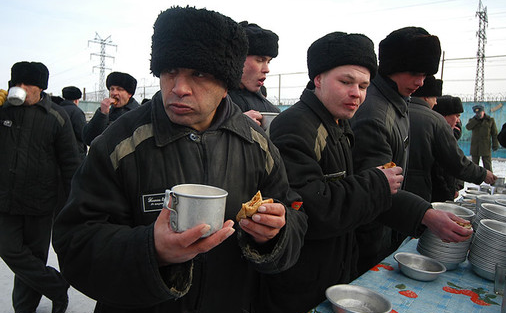
According to government estimates 712,500 Russians are currently behind bars. Mutinies in prisons had happened in the past. One example: in January 2008 at a prison in the Amur region 700 inmates slit their wrists, protesting abuses. It led to criminal charges against the inmates. Official checks failed to validate their complaints.
The mutiny in Kopeisk is the first case, when inmates’ rebellion has attracted a large amount of attention. Even state television — usually deaf to reports of widespread abuse and corruption in the nation’s prison system — had devoted prime-time programming to developments of the event. One of reasons for this new openness is the Internet, which makes it impossible for the government to hide these type of events from the public.
“There hasn’t been anything like it for a long time,” – said Nadezhda Radnayeva, an expert at the In the Defense of the Rights of Prisoners Foundation, – “A typical revolt involves a few dozen of inmates. The rest are too afraid, have a separate agenda, or come to an agreement with administrators. Hence the shock created on the Internet by footage from the Kopeisk’s prison, which showed hundreds of prisoners standing on the roof of a building above a homemade banner reading, ‘Free people, help us! The administration is extorting money, torturing and humiliating us.’”
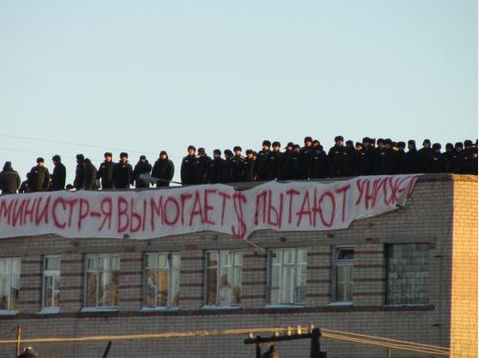
November 24 was the day of a yearly mass visit to the prison by the relatives of the prisoners. The inmates seized a guard point, came out into the hallway and onto the roof, and hung out the banner calling for help. The banner was addressed to the crowd of relatives gathered near the prison wall. Some relatives had telephones with cameras. Photos and videos of rebels immediately reached the Internet. Some journalists and human rights activists joined the relatives at the gates of the prison.
Here is how the events were described in the official police report:
“Before dinnertime at 11:30am Moscow time, 250 convicts in six groups went into the corridor of the prison residential zone and made illegal demands to loosen the imprisonment regime, particularly to release several convicts from the punishment cell after they were put there for violations of the prison rules”.
Nikolai Shchur, a local human rights activist and part of a small group allowed inside the prison after the start of the riot, contested claims made by officials. He said the revolt involved “all” (1500) prisoners, not 250; prisoners demanded media attention, not “a relaxed regime” or freedom for a comrade in solitary confinement; and the revolt was spontaneous, not planned by so-called criminal ringleaders.
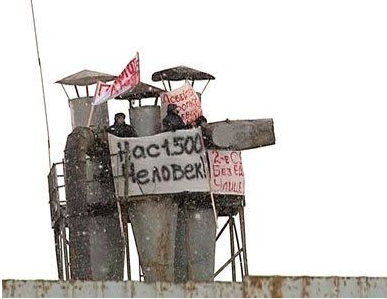
Nikolai Shchur also said that interviews with about 30 inmates confirmed allegations of abuse and extortion by prison officials.
“We have not found out anything new about this colony. … We’ve known this all for two years and don’t only know it, but we’ve also constantly talked about it and filed complaints. … We’ve received no response.”
At the start of the riot, entering the town was banned to outsiders. Police and special armed security forces arrived in large numbers and started beating everyone in the crowd outside of the prison and breaking windows of the visitors’ cars. Using their shields, they shoved the crowd from the prison walls. The rebels from the roof were pleading to relatives: “Don’t abandon us, they will kill us!” Several of the relatives were taken away in ambulances, carried off, unconscious. Thirty-eight persons were arrested.
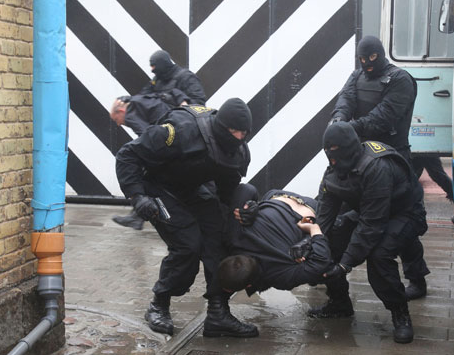
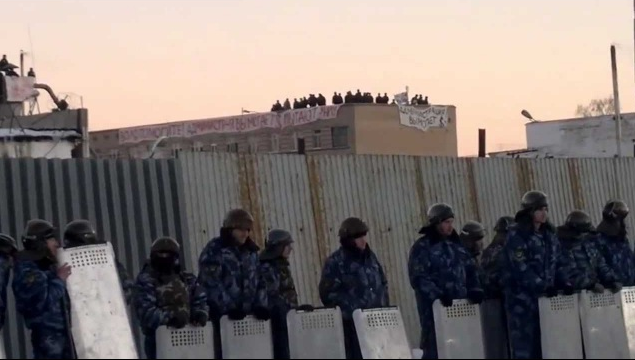
According to some Russian Internet blogs, sounds like gunfire were heard for some time. There are unconfirmed reports that 12 people were killed (this is the minimum figure and, according to rumors, all the town’s morgues are full). The rebellion was crushed.
On November 26 under pressure from activists and media, the Prosecutor General’s office released the statement: An initial check of Correctional Facility #6 failed to confirm prisoners’ claims of beatings or any other form of bodily harm.
Correctional Facility #6, (alongside with other such facilities, including another Kopeisk’s prison Facility #1) was previously attracting attention of human rights activists on accounts of prisoners being beaten and tortured by guards on numerous occasions. In an infamous case a year ago, several guards initiated an escape attempt by four prisoners as an excuse to kill those prisoners.
In May 2008, four inmates at Facility #1 died after being savagely beaten by officers and denied medical attention. Another died of alleged maltreatment in June.
On several occasions there were reported cases of prisoners buying their release on parole. A man identified as Andrei T., convicted of manslaughter and sentenced to six years in prison in 2008, said he paid 50,000 rubles ($1,600) for his freedom.
Nadezhda Radnayeva, who was quoted earlier, says: “Everybody understands that lawlessness in prisons exists, but either they’re afraid to intervene or they’re too lazy to figure it out”. She claims that ninety percent of the complaints that her organization makes to official agencies come back with a single reply: “Not enough evidence.”
Marina, the wife of one of the prisoners told a reporter:
“My husband spent a year here. They put him into a punishment cell and demanded money for letting him out. He explained them that his wife has little children and they agreed to take just 5000 rubles ($250). I paid this money. They let him out of the cell. Then they started taking money for visits. You want to see him, pay 4500.”
Here are excerpts from a publication by Oksana Trufanova, the coordinator of civil rights group Gulagu.net, who was beaten by police at the gates of the prison:
“This situation has been brewing for a long time. For a year I’ve been watching what was going on in this Facility. Complaints are a never-ending stream.
“Inmates are fed up with such attitude. Extortions are never ending, prison officers say: ‘Just pay 30 k and we are not going to touch you.’ Next month it is about 40 k. Then – about 90 k. Then the mother of one of the prisoners was told to bring 200 thousand…
“There is a disabled prisoner Arthur Sargisian over there. He has frost-bitten legs, they don’t function.. He faces amputation. He is in a PUNISHMENT CELL. He creeps on the cell’s floor. The video shoot is not allowed. He is not placed in a hospital.”
After the mutiny in the Facility #6, the Investigation Committee initiated a criminal case under article “abuse of powers”. Also five criminal cases were initiated against relatives of convicts because of injuries made to armed soldier and police in clashes at the gates of the prison.
Just at the moment when I was finishing writing this article, the Internet brought me news that Oksana Trufanova was arrested in connection with her publications about Kopeisk riot.
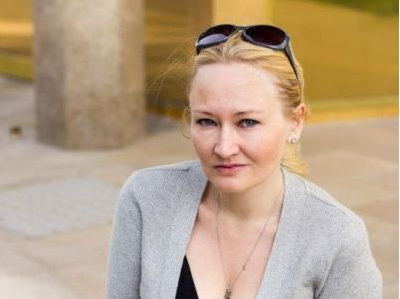
Oksana Trufanova

